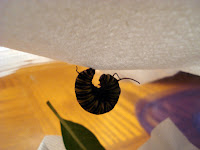





We see our caterpillars are in various stages of beginning the process of pupating. From the Monarchs in Space Teachers Guide we understand that a caterpillar will empty its gut when it has finished developing and at that time produces frass with a pinkish hue. Pinkish frass is visible in the rearing boxes today. After emptying its gut, a monarch caterpillar will search for a sheltered, horizontal surface; as we see the caterpillars are orienting to the underside of the top of the rearing boxes.
To attach securely for the duration of the pupal (chrysalis) stage, the caterpillar spins a bed of silk and then a silk button in the center. It is from this button, with its anal prolegs (these are the pair of suction cup legs at the end of the caterpillar) anchored by crochets (tiny hooks on the legs) that the caterpillar releases it's hold and hangs like a letter J, upside down. It may, depending on the temperature, hang in this position for 12-16 hours.
Toward the end of the J stage, the caterpillar's color changes due to the chrysalis developing inside and the caterpillar usually straightens in its hanging position. What happens next, happens quickly. Simply stated, the caterpillar succumbs to contractions that cause the caterpillar's skin to split and move upward toward the silk button attachment, revealing the chrysalis that has been forming. When the skin reaches the silk button, the caterpillar's cremaster is released and pushed into the silk button and the chrysalis twists to secure the cremaster to the silk.
Over the next few hours as this process repeats itself in our rearing boxes, we expect to see these beautiful, lime green jewels of metamorphosis hanging where our letter J stage caterpillars are hanging now.










